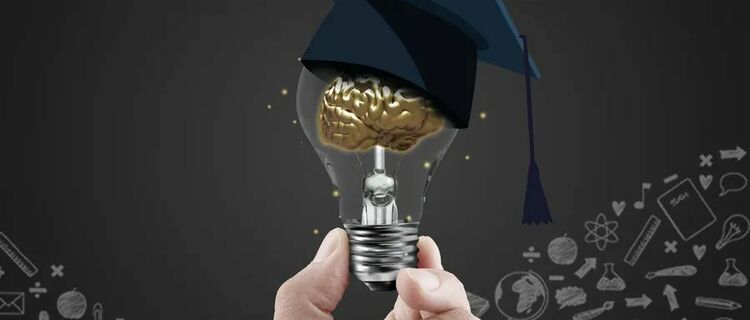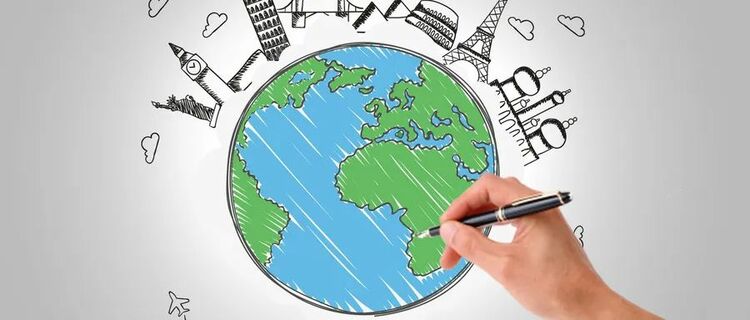Creative Thinking in Schools:
From Local Action to Global Policy,
From Individual Learners to Interdisciplinary Approaches
By: Mehri Madarshahi and Hans d'Orville

Since 2020, some 147 million students are missing half of their in-person instructions at schools. The COVID pandemic has harmed the learning of more than 90% of the world's children – with half of all countries cutting their education budgets, further deepening the crisis. It is now estimated that 64.3% of 10-year-olds are unable to read and understand a simple story. This means that, in a few years, 1 out of 3 persons will not understand this very text, while 840 million young people will leave school in their teens with no qualifications for the workplace of the future. A worrying sign is that only less than half of all countries have strategies to help children to catch up. With their lost education years, these students stand to lose $10 trillion in earnings over their working live.
In the US, many students whose final years of high school have been disrupted by the pandemic are struggling in crucial college courses. In Europe, according to latest OECD findings, nearly one in five 15-year-old students do not acquire the minimum skills necessary to participate fully today. According to the World Bank, some 16% of recent reforms focus on ensuring quality and equity in education. Some 29% of measures aim to better prepare students for the future. To this end, many countries have focused on improving the quality and relevance of technical and vocational education and training (TVET) programs.

On 19 October 2022, in connexon with the UN's Transforming Education Summit (TES), 130 countries committed to rebooting their education systems and accelerating action to end the learning crisis. TES dealt with a crisis in education that is considered the largest disruption in learning history. Speaking at the Summit, the UN Secretary-General underscored that if there was one seed to prevent climate change, violent conflict, or poverty, it was education. He further observed with regret that "Instead of being the great enabler, education is fast becoming the great divider. The rich have access to the best resources, schools, and universities, leading to the best jobs while the poor – especially girls – face huge obstacles to getting the qualifications that could change their lives."
On the opening day of this 3-day Summit, youth advocates shared a Youth Declaration with the Secretary-General, laying out their collective recommendations to policymakers on the transformation they want to see, along with their commitments for action on education.
The Youth Declaration was a culmination of a months-long process of consultations, reflecting contributions from almost half a million young people. The Declaration stated that "in order to redeem and remake the state of the world, we must first transform the state of education." The Declaration demanded that decision-makers include youth in education-related policy design and implementation, as partners and not just beneficiaries. It also demanded investment in youth leadership and in gender-transformative education.
In educating the future generation, we are obligated to look more deeply into the role of education itself. Education as a concept is undergoing change at an unprecedented rate.

Many countries today face the challenge of persistent unemployment, among youth as well as older workers, while employers often report that they are unable to find suitably skilled candidates to fill job vacancies. Employers, policy makers and education institutions could strengthen co-operation mechanisms to increase the employability of individuals. This co-operation should reinforce incentives to undertake the sorts of reforms required in education systems and labor markets by improving their policy design and implementation.
The current knowledge-based education system only goes so far in giving young people the vital skills, resilience, and confidence to shape their lives. From standardized tests to one-size-fits-all curricula, public education often leaves little room for creativity. This puts many schools out of sync with societal needs, leaving students poorly prepared for future success. Creative mindsets are crucial for the future development of societies at large.
While there are certainly inherent benefits of traditional rote learning and using standardized testing as a measure of performance, we know the next generation will need far more abstract and interchangeable skills. From fighting climate change to keeping up with the global digital revolution, the future generation of problem-solvers will need to overcome some of the world's toughest obstacles by thinking in new and creative ways with bold ideas and the determination to challenge the impossible.
Education is, however, a complex process and undergoing change at an unprecedented rate. Today, education demands the very best from parents, teachers, students, and administrators. To prepare to succeed in the global economy, students need new skills, taught in new ways. Teachers need to develop new materials and deliver them differently. Parents expect greater involvement, and administrators need to constantly improve administration and management efficiencies.

Today's major shift in education discourse and practice recognizes the relevance of learning, understanding and resolving global issues in social, political, cultural, economic, and environmental issues. These requirements are moving the role of education beyond the development of knowledge and cognitive skills to rather building of values, soft skills, and attitudes among learners. Education is expected to facilitate international cooperation and promote social transformation in innovative ways towards a more just, peaceful, tolerant, inclusive, secure, and sustainable world. In an increasingly interconnected and interdependent world, there is a need for transformative pedagogy that enables learners to resolve persistent challenges related to sustainable development and peace that concern all humanity. These include conflict, poverty, climate change, energy security, unequal population distribution, and all forms of inequality and injustice which highlight the need for cooperation and collaboration among countries going beyond their land, air, and water boundaries.
These are changes and transformations that a decade ago, no one could have predicted. Their sheer pace of change and the extraordinary circumstances are characterizing today's world — from adapting to the learning needs in the wake of a global pandemic to empowering and building a digital generation that has proved capable of starting billion-dollar companies virtually overnight. As a result of globalization and the digital revolution, the last decade alone, we have witnessed complete transformations of entire industries through access to technology and innovations. Creativity and abstract thinking have become prerequisites in a student's repertoire of skills needed for their future and the future of society. Today, educators in both physical and digital classrooms must play a vital role in fostering and encouraging the impending transformation by transmitting knowledge to students.
It is fair to say that creativity has been the driving force behind the most groundbreaking innovations of our time. We are surrounded by innovation that would not have happened were it not for incredibly creative and determined people embracing ambiguity, challenging the status quo, not taking no for an answer, and discovering new ways to solve all kinds of problems.
But what exactly is creativity and how it could be used in education?
In essence creativity produces something new, relevant, and useful. There is a broad consensus that creativity comprises the interaction between the learning environment, both physical and social, the attitudes and attributes of both teachers and students, and a clear problem-solving process which produces a perceptible product (which can be an idea, a process, or a tangible physical object).
Creativity is valuable in education. It builds cognitive complexity. Being creative involves using an existing set of knowledge or skills in a particular context and experiment with new possibilities in the pursuit of outcomes enhancing both knowledge and skills. Doing things better, faster, higher, cheaper, and more effectively has for long constituted the model of success for economies worldwide.
Doing new things in new ways is tantamount to the quest for innovation and creativity. Innovation, the business of ideas, is increasingly seen as the key to future societal prosperity, business success and individual advance.
Innovation includes not only ingenuity and imagination, but even more so new processes, new technologies, and new ways of using all sorts of technology. As we can witness daily, new technologies are opening vast opportunities for creating and sharing knowledge.
The role and importance of creativity in the classroom
A classroom environment is one of the most important places to start encouraging and nurturing creativity in young people. Today's world is changing at an unprecedented rate — and for millions of educators around the world, today may be the single most critical period in history to embrace the benefits of creativity is the classroom. Research also suggests creativity thrives when it is socially engaged, which makes the classroom the perfect breeding ground for innovative and creative teaching. Embracing creativity in the classroom is a great way to challenge the notion of static learning: the idea that there's merely one correct way to solve a problem or come to a solution.
Today's students will be taking on careers that we have not yet imagined as we work to solve some of the world's greatest problems, from climate change to inequality and large-scale conflict, through to advancing technologies across every possible industry. With that in mind, we owe it to the next generation to empower them with creative thinking and problem-solving skills. It doesn't necessarily start when a student reaches school, it is during this critical time where it needs to be nurtured and encountered.
Children are best positioned to develop their ways of thinking and solving problems as they are naturally inquisitive, open to learning, imaginative and they do not often feel embarrassed by novelty, since everything is new and consequently nothing is abnormal.
An additional benefit of creativity in the classroom is also to encourage students to think independently and solve problems autonomously. By empowering students to push the boundaries, question norms and think outside the box, educators can build and promote confidence and self-esteem in students.
All in all, creativity has become a prerequisite for innovation and will be an increasingly in-demand skill for jobs of the future. On the other hand, creativity doesn't need to be a subject of its own. Every subject can be creative and could be interwoven into the entire curriculum. Even the more defined and structured topics like math and science have areas where creativity can be embedded into the topic to encourage a greater depth of understanding with students.
Other ways to teach and encourage creativity in the classroom include:
Set time aside for journaling
Participate in five minutes of mindfulness each day
Build brainstorming sessions
Use gamification to encourage participation
Encourage risk taking
Leave the classroom more often
Allow students to teach
Use visual aids
Encourage questions
Final thoughts
To operationalize education associated with sustainability, teaching approaches must focus on elements relating to the processes of learning, rather than the accumulation of knowledge—to develop graduates with capabilities to improvise, adapt, innovate, and be creative. To that effect, skills such as interdisciplinary thinking, problem solving, team working, and holistic thinking are often mentioned.
To enhance the effectiveness of tertiary education, a major driver of economic competitiveness, policies should focus on relevance to the labor market and quality control. Many countries have adopted policies to support effective student transitions across education or into the labor market through a national strategy, youth guarantee policies or the development of qualifications frameworks. Analysis shows that key factors for an effective implementation of such system is putting the student and learning at the center with capacity-building and leadership trainings.
Youth need to be acknowledged and supported not only as learners, but also as educators, advocates, and leaders. To make this happen, the engagement and participation of young people should be encouraged and supported so that their involvement is not merely tokenistic. Young people are not ‘future citizens' but active citizens now.
Teachers can support students to develop the attitudes and attributes required for creativity, which include persistence, discipline, resilience, and curiosity. In this way, teachers can support the creative process, moving from problem posing, to problem solving and on to idea generation. The traditional way of requiring students to memorize and regurgitate answers to fixed questions does not lend itself to living in today's complex world. Over time, creative intelligence is becoming a new form of cultural literacy. It harnesses the power to create, connect and inspire.
Standing at the crossroad?
We must act now to eliminate poverty and bring about more social inclusion, to enhance educational and health levels, to mitigate the pace and effects of climate change, ecological degradation, and to prevent the loss of biodiversity. All these pose threats for every country and every person in developed and developing countries alike.
The United Nations designated 2021 as the International Year of Creative Economy for Development, led by UNCTAD. In China, the International Center for Creativity and Sustainable Development (ICCSD in Beijing), under the auspices of UNESCO organized joint events with several partners and has launched with CREATIVITY 2030 (C2030) a global initiative which seeks to stimulate, mobilize, and exchange creative solutions, tools, and approaches in all walks of life by creative cities.
Since 2004, the ever-expanding UNESCO Creative Cities Network (UCCN), now counting more than 300 members from over 100 countries, leverages the ability of cities to bring creative actors together, to spark economic growth through new products and services, to foster a sense of community and to preserve urban identities and heritage.
Some of the world's leading cities have been named by UNESCO as creative cities of design — among them Beijing, Berlin, Brasilia, Budapest, Buenos Aires, Detroit, Istanbul, Mexico City, Seoul, Shanghai, Shenzhen, and Torino. This designation recognizes the dynamism, drive and innovation that have inspired and put their stamp on such cities.
All countries are challenged to devise policy strategies, mobilize new technologies and make progress in reducing unsustainable behavior and consumption. Many of the world's private sector companies are engaged in green innovation — based on research and development for new generations of green products, technologies, and jobs — followed by the inclusion of green elements in the supply chains and the social dimensions of products. Education, training, and learning will have to play a major role in these endeavors.
Coherent policies, structural changes, new solutions, innovations across the board, and creativity all around, especially in schools and the education system - in coherent manner - could build a strong pillar for education today and an engaged and productive community of nations for tomorrow.
Education reform can only be effective if policies are well implemented. This means that, to support reforms in evaluation and assessment, there must be a coherent framework in place, with sufficient capacity for conducting and interpreting evaluations at all levels of the education system. To successfully introduce innovations in the learning environment, policy makers must concretely address specific teaching and learning issues. And to improve the quality of the education that schools provide, policies must focus on changing classroom practices, balancing external pressure and support, developing, and pursuing long-term objectives.
These tasks and more call for underlining the need for effective education policy reforms: Innovation, growth, social cohesion, migration, and new technologies require investing in quality education outcomes. In our fast-changing knowledge economies, with globalization, heightened competition, changing labor markets and employment instability, citizens must learn skills for the jobs of today, tomorrow and the years to come.
To achieve long-term sustainability, we must strive for a green economy, accelerate circular economies, and come up with creative solutions to address limitations to resource footprints.